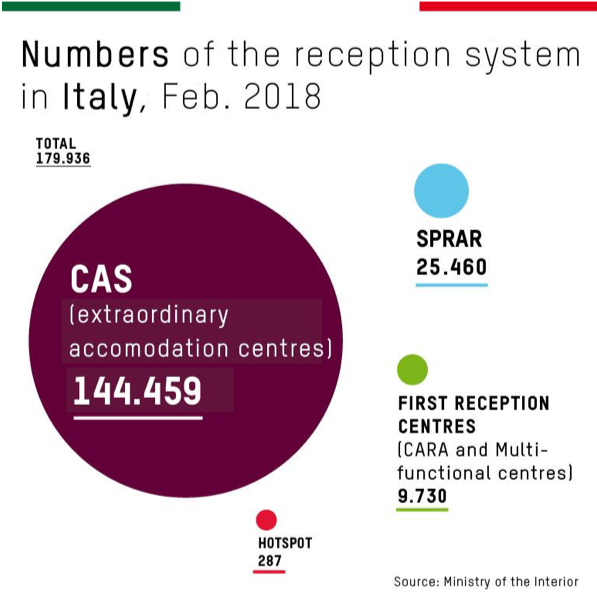The Italian reception system
Back to: The Italian Asylum System and Its Functions
The Italian reception system never rejected the emergency assistance view that inspired it. This becomes clear when the data about the structural nature of the phenomenon of refugees is considered: in the light of the current economic, cultural and geopolitical dynamics it is easy to predict that it will remain stable, or maybe it will increase, in the coming years. Despite the drastic reduction in the landings to our shores since July 2017, migration flows always tend to find another route when the one they are following is shut down. The problem is that new routes often pose more dangers than the abandoned ones.
As Giuseppe Campesi observed, «over the last ten years, the border controls and the arrival of irregular migrants to the Italian shores have been managed as if we were in what can be described as a “permanent emergency” (Campesi, 2011, pp. 8-9).
The reception system is made of diversified structures according to the number of places available, the conditions and the standards of the services provided.
The core of the system is the SPRAR, the “System of Protection for Asylum-Seekers and Refugees”, coordinated by local authorities and matched, since 2014, by the CAS (Extraordinary Accommodation Centres). These latter temporary structures have been activated by local prefectures on behalf of the Ministry of the Interior and represent around 80% of all the beneficiaries of the reception system, distributed in 7.000 structures throughout the entire Italian territory.
<h2>Numbers of the reception system</h2>
Sleeping accommodations have been made available in flats, hotels, nursing homes and hostels by organizations, cooperatives, associations and other private bodies, for an average cost of EUR 30/35 a day for every host. Originated as a system responding to humanitarian emergencies in a short-term perspective, the CAS system is now proving to be biased and inappropriate to provide a solution to the reception of the hosted migrants, whose stay often goes on for years. In such a way, the SPRAR centralized system of small centres, directly managed by the local authorities, the heterogeneous CASs, the governmental centres CARAs and the First Reception Centres coexist.
The data on the presence of refugees and asylum-seekers in the diverse Italian regions have not changed significantly since 2015. The Lombardy region accommodates the greatest number of immigrants with almost 25.000 individuals; Campania follows with 16.000 presences and the regions of Lazio and Sicily come right after them. If, on the one hand, we notice a greater distribution of refugees over the national territory, on the other one the services provided by the 7.000 CASs definitely appear fragmented and uneven.
In addition, due to the overload of the system and the shortage of space, refugees and other individuals with diversified statuses can stay in First Reception Centres for months, while the SPRAR program accommodates both those covered by protection and the ones seeking it. CASs, on the other hand, are this system’s outlets, hosting heterogeneous beneficiaries, most of which have only just arrived.
